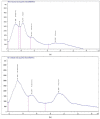Promoting Effect of Soluble Polysaccharides Extracted from Ulva spp. on Zea mays L. Growth
- PMID: 35209184
- PMCID: PMC8879857
- DOI: 10.3390/molecules27041394
Promoting Effect of Soluble Polysaccharides Extracted from Ulva spp. on Zea mays L. Growth
Abstract
Seaweeds can play a vital role in plant growth promotion. Two concentrations (5 and 10 mg/mL) of soluble polysaccharides extracted from the green macroalgae Ulva fasciata and Ulva lactuca were tested on Zea mays L. The carbohydrate and protein contents, and antioxidant activities (phenols, ascorbic, peroxidase, and catalase) were measured, as well as the protein banding patterns. The soluble polysaccharides at 5 mg/mL had the greatest effect on the base of all of the parameters. The highest effects of soluble polysaccharides on the Zea mays were 38.453, 96.76, 4, 835, 1.658, 7.462, and 38615.19, mg/mL for carbohydrates, proteins, phenol, µg ascorbic/mL, mg peroxidase/g dry tissue, and units/g tissue of catalase, respectively. The total number of protein bands (as determined by SDS PAGE) was not changed, but the density of the bands was correlated to the treatments. The highest band density and promoting effect were correlated to 5 mg/mL soluble polysaccharide treatments extracted from Ulva fasciata in Zea mays, which can be used as a biofertilizer.
Keywords: SDS PAGE; Ulva fasciata; Ulva lactuca; Zea mays; antioxidants; polysaccharides; protein.
Conflict of interest statement
The authors declare that they have no known competing interest.
Figures












References
-
- Gibbon D., Pain A. Crops of Drier Regions of the Tropics. Longman Publishing Limited; Singapore: 1985.
-
- Subramaniyan V., Malliga. P. Effect of Cyanopith Biofertilizer as Basal and Spray on Zea mays (Corn) Int. J. Environ. Sci. 2011;2:661–670.
-
- Schwietzke S., Kim Y., Ximenes E., Mosier N., Ladisch M. Molecular Genetic Approaches to Maize Improvement. Springer; Berlin/Heidelberg, Germany: 2009. Ethanol production from maize; pp. 347–364.
-
- Ahmed A.A.S. Master Thesis. Botany Deptartment, Faculty of Science, Beni-Suef University; Beni-Suef, Egypt: 2009. Cyanobacterial Application for the Improvement of Soil Fertility.
MeSH terms
Substances
LinkOut - more resources
Full Text Sources
Miscellaneous

